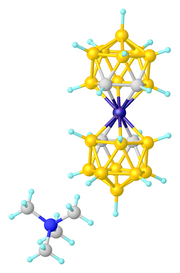Metallaborane

In
Examples

Two simple examples are B4H8Fe(CO)3 and B4H8Co(C5H5). The MB4 cores (M = Fe or Co) of these two compounds adopt structures expected for nido 5-vertex clusters. The iron compound is produced by reaction of diiron nonacarbonyl with pentaborane. B4H8Fe(CO)3 and cyclobutadieneiron tricarbonyl have similar structures.
Metallacarboranes

Even greater in scope than metalloboranes are metallacarboranes. These cages have carbon vertices, often CH, in addition to BH and M vertices.
Some metalloboranes are derived by the metalation of neutral carboranes. Illustrative are the six-and seven-vertex cages prepared from closo-C2B3H5. Reaction of this carborane with iron carbonyl sources gives closo Fe- and Fe2-containing products, according to these idealized equations:[6]
- C2B3H5 + Fe2(CO)9 → C2B3H5Fe(CO)3 + Fe(CO)5 + CO
- C2B3H5Fe(CO)3 + Fe2(CO)9 → C2B3H5(Fe(CO)3)2 + Fe(CO)5 + CO
A further example of insertion into a closo carborane is the synthesis of the yellow-orange solid closo-1,2,3-(CO)3FeC2B4H6:
- closo−C2B4H8 + Fe2(CO)9 → closo−(CO)3FeC2B4H6 + Fe(CO)5 + CO
A closely related reaction involves the capping of an anionic nido carborane C2B4H−7
- closo−C2B4H8 + NaH → Na(nido−B4H7) + H2
- Na(nido−B4H7) + CoCl2 + NaC5H5 → closo−(C5H5)CoB4H6 + 2 NaCl + ...
The last reaction is worked up with acid and air.
References
- .
- ^ ISBN 978-0-08-037941-8.
- ISBN 9780306409332.
- .
- .
- ISBN 9780080465180.
